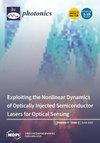An Efficient Design Method for a Metasurface Polarizer with High Transmittance and Extinction Ratio
IF 1.9
4区 物理与天体物理
Q2 OPTICS
引用次数: 0
Abstract
In fields such as polarization navigation and imaging, there is a demand for polarizers to simultaneously possess a high transmittance and extinction ratio. However, most studies focus solely on a single metric for polarizer design. To address this issue, this paper proposed a metasurface polarizer with a transition layer and its efficient design method, aiming to enhance the polarizers’ transmittance and extinction ratio performance simultaneously. An all-dielectric metasurface polarizer with a TiO2 transition layer was designed, and a tandem neural network was constructed by combining forward prediction and inverse design networks. The network is successfully trained by utilizing structural parameters and spectral response Tx and Ty datasets collected through simulation software. A high-performance metasurface polarizer was designed under the desired metrics with a transmittance of 90% and an extinction ratio of 40 dB. The proposed method in this paper made progress in the comprehensive optimization of polarizer performance. It is more accurate and efficient compared to other design methods and is better suited for practical applications.具有高透射率和消光比的金属表面偏振器的高效设计方法
在偏振导航和成像等领域,需要偏振片同时具有高透光率和消光比。然而,大多数研究仅关注偏振片设计的单一指标。针对这一问题,本文提出了一种带有过渡层的超表面偏振片及其高效设计方法,旨在同时提高偏振片的透过率和消光比性能。本文设计了一种带有 TiO2 过渡层的全介质元表面偏振片,并结合正向预测和反向设计网络构建了串联神经网络。利用仿真软件收集的结构参数和频谱响应 Tx 和 Ty 数据集,成功地训练了该网络。根据所需的指标,设计出了透射率为 90%、消光比为 40 dB 的高性能元表面偏振器。本文提出的方法在偏振片性能综合优化方面取得了进展。与其他设计方法相比,该方法更精确、更高效,更适合实际应用。
本文章由计算机程序翻译,如有差异,请以英文原文为准。
求助全文
约1分钟内获得全文
求助全文
来源期刊

Photonics
Physics and Astronomy-Instrumentation
CiteScore
2.60
自引率
20.80%
发文量
817
审稿时长
8 weeks
期刊介绍:
Photonics (ISSN 2304-6732) aims at a fast turn around time for peer-reviewing manuscripts and producing accepted articles. The online-only and open access nature of the journal will allow for a speedy and wide circulation of your research as well as review articles. We aim at establishing Photonics as a leading venue for publishing high impact fundamental research but also applications of optics and photonics. The journal particularly welcomes both theoretical (simulation) and experimental research. Our aim is to encourage scientists to publish their experimental and theoretical results in as much detail as possible. There is no restriction on the length of the papers. The full experimental details must be provided so that the results can be reproduced. Electronic files and software regarding the full details of the calculation and experimental procedure, if unable to be published in a normal way, can be deposited as supplementary material.
 求助内容:
求助内容: 应助结果提醒方式:
应助结果提醒方式:


